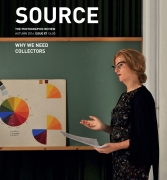Hidden People
by Gail Baylis
Issue 87 Autumn 2016
View Contents ▸
Making photographs is a performative act for Trish Morrissey, one that allows her to explore the boundaries of the language of photography. This is a strategy that she continues in Ten People in a Suitcase. As with previous work, Morrissey inserts herself as the subject in these photographs. This introduces a fiction into the key authority claim of analogue photography, its indexical link. Comparisons between Morrissey’s practice and the work of Cindy Sherman are often drawn, most notably in that both photographers choose to make themselves the subject of the work. However the aims differ: where Sherman in the Untitled Film Stills sought to expose how collective popular fantasies are based on interchangeable visual signs that render femininity a masquerade, Morrissey, in this series, works to both embody the image and also to acknowledge the presence of the original subject.
This new work derives from a residency that Morrissey undertook at Mänttä, Finland in 2014 and is a response to an archive of over 30,000 photographs, often of anonymous subjects that record the life of the town. Mänttä’s prosperity derived from paper production and the selected archival images document commercial photographic practice operating in this industrial town over a historic span. Ten People in a Suitcase acknowledges that history in both its ordering of photographs and titles. The photographs are ordered in an historical sequence from the 1920s to the 1980s. Morrissey has a keen eye for the range of commercial photographic practice and its shifts in stylistics; the ordering of images suggest a commentary on both that practice and also the character of this once prosperous town whose inhabitants have now declined to just over 6,000. Fig. 01832KEL (TM) - Tapani Kansa sang at Kirstinharju dance pavilion. Departure - 1970 / 2015, Mänttä, Finland
Fig. 01832KEL (TM) - Tapani Kansa sang at Kirstinharju dance pavilion. Departure - 1970 / 2015, Mänttä, Finland
The title for each photograph includes an archive catalogue number, a date and brief informational description, which retains the bare factuality of a catalogue entry. Augmenting this is the inclusion of the date of Morrissey’s version. These photographs are not re-enactments but rather new photographs that aim to inhabit and re-animate the lives of the original subjects that have been made generic both by the dictates of commercial practice and also the protocols of archival indexing.
Allan Sekula’s essay ‘Reading an archive: photography between labour and capital’ critiques how the archive serves as a store house that can be mined through selection of photographs to aestheticise meaning and in the process obfuscate the original dictates of photographic practice. Morrissey has managed to avoid such a pitfall through her close attention to the genre conventions of commercial practice. Here her early experiences working on the Irish newspaper The Independent may have comes in useful. During that time not only did she learn the procedures of printing and archiving press photographs, she also, on occasions, found herself the model for photographs that appeared in the newspaper. Such experiences attuned her to both the rhetoric of the press image and also its fictive documentary dimension. These clearly posed and generically-led images expose the information imperative of the seemingly standardised image – the public information image, the industrial promotional shot or the apparently caught-shot of labour. The effect is to bring into relief the original commercial dictates for the image and Morrissey’s re-imaging of the scene which serves to animate it.
There is, above the rendering of genre conventions, a stretching of the boundaries of what the photograph can say. Gender, in this context, emerges not so much as an unstable sign but as a range of possibilities that can be inhabited at points of affective identification: be it the doleful expression of the now rendered androgynous-looking person in A person who has lost a hand in an accident Work safety campaign; the self-conscious, tentative smile of Aune Heimolainen, one of the best swimmer girls in Mänttä Sporting Club; the posing in Father and son clay pigeon shooting day at Särkikangas sandpit or the conscious tilt of the head and hand resting pointedly on the products’ display stand of Miss Tuula Järvenpää (The Serla Girl) domestic sales. Morrissey has spoken of how the selected photographs were chosen for a look to camera, the angle of the hand or how the subject inhabited the frame. Such a response recalls what Roland Bathes describes as the photograph’s ability to produce punctum – an affecting personal response to the image. In this context, what are we to make of the reimaging of Adult Education Centre’s painting and drawing class. Teacher Riitta Ranta, the unwelcoming glance to camera of the typist in KMV-news office or the curious back-view in Tapani Kansa sang at Kirstinharju dance pavilion. Departure?
What has been produced here offers both access to the image and also renders an elusive quality to it. Morrissey works to embody the lives of the subjects she has chosen and to speak of what those connections mean to her. Ultimately, this is a creative exploration of how photographs can be understood in different ways.
Other articles mentioning Trish Morrissey:
Other articles mentioning Allan Sekula:
Other articles mentioning Cindy Sherman:






